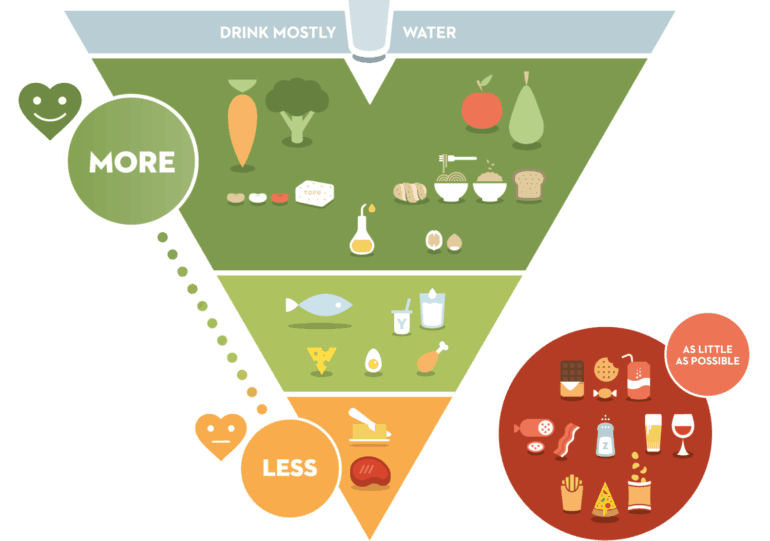
Photograph courtesy of the Vlaams Instituut Gezond Leven, Belgium.
Belgium recently released its new food guide for a healthy living. Represented as an inverted nutritional pyramid, the guide advises citizens to drink more water, eat a more plant-based diet, and reduce consumption of dairy, meat, and products with high sugar, salt, and fat content. It was designed by the Flemish Institute for Healthy Living (Vlaams Instituut Gezond Leven), an institute working with the Flemish government on health promotion and preventive nutrition.
The Institute created levels within the pyramid which divide the food products into zones, indicating their impact on health: the green zone items should be eaten more, and orange zone items should be eaten less. The red zone, which consists of sugary drinks, alcohol, processed food (including processed meat such as bacon and pepperoni), and ready-to-eat food products, is depicted in a circle outside of the pyramid, as it should be eaten as little as possible.
Basic food products that undergo small processing operations, which can reduce the health quotient but still contain some nutritional value—such as salted peanuts, fruit juices, chocolate milk, white bread, and yogurts with added sugar—also form a grey zonethat is not depicted in the model.
According to Loes Neven, a Senior staff member and Nutrition Coordinator , of the Flemish Institute for Healthy Living, “The average inhabitant of Flanders—the northern, Dutch-speaking part of Belgium—eats too much meat and too many foods from the red zone (mostly ultra-processed foods rich in added sugar, salt, and fat). They under-consume fruit, vegetables, and whole grains (plant-based foods in general). Adolescents have the worst dietary habits of all ages.”
Data from the Global Health Observatory (GHO) shows Belgium’s population as 59.5 percent overweight and 22.1 percent obese. And worldwide obesity has increased three times since 1975, with overweight men and women accounting for 39 percent each in 2016, according to World Health Organization’s (WHO). Belgium’s new nutrition model is part of the country’s ongoing efforts to promote a healthy diet across the nation. The first educational model in Belgium focused on food was developed in 1967 and has undergone many changes since then, incorporating various aspects of health, diet, and physical fitness.
“We tested the earlier drafts of the model for understandability in consumer groups (with a focus on vulnerable groups, like adolescents or adults with lower education),” Neven explained. “We also considered the recent evolution in nutrition science to pay more attention to the health effects of foods and food patterns as a whole. Therefore, we no longer group and rank foods by the main nutrients they deliver, but by their effect on health (based on available scientific evidence). For example, in the former pyramid meat (all types), fish, eggs, legumes, and vegetarian meat substitutes were all grouped together as protein sources.”
The new inverted nutritional pyramid model focuses on simplicity, a separation of nutrition from physical activity, timeless symbols, and most noticeably, a revised shape. The Flemish Institute explains how the original triangle-shaped nutritional pyramid was misinterpreted and subconsciously read from top to bottom, where the top tier—consisting of meat, dairy, and high-fat content food products—was could be thought to mean “less, but exclusive and more important” and the bottom-most tier as “more, but less exclusive and less important.” The Institute found that, because of this, the consumption of the top-tier food products increased.
The newly released inverted triangle form is similar to the double food and environmental pyramid (DP) released in 2010 by the Barilla Center for Food & Nutrition (BCFN) Foundation. The double food and environmental pyramid was created to explain the interrelation between the food consumed and its environmental impact.
In BCFN’s DP model, the food pyramid consists of six tiers on the foundation of fruits, vegetables, and water, while the topmost tier consists of desserts and meat. The food products in the six tiers are placed according to the nutritional groups most important for a healthy diet. The environmental inverted pyramid occupies the space adjacent to the food pyramid. The food products are separated into different tiers based on their overall environmental impact, calculated by their ecological, carbon, and water footprints. According to the ecological footprint indicator, red meat and fat products such as butter, margarine, and cheese have a greater environmental impact.
Researchers at the Flemish Institute for Healthy Living drew similar conclusions through their extensive research and interactions with experts on sustainable eating. “We considered the effect on the environment as a second criterium (besides effect on health) to group and ranked the foods in the pyramid,” Nevens explains. He suggests recommendations for sustainable eating, to “consume more plant-based foods than foods from animal origin (clearly visualized in the triangle), and avoid food waste and overconsumption (especially from unnecessary and potentially health-damaging foods).”
Neven hopes this new model provides a complete guide to a healthy diet that is more easily applicable to everyday life. The Institute website contains tips and quick Do It Yourself (DIY) nutritious meal options. They provide information on educational programs and partnerships with health professionals, organizations, and various other workplaces.
“The aim of the new triangle is primarily educational,” Neven says, “but through other initiatives, our institute wants to create an environment where the healthy choice is the easy choice.”
[“Source-foodtank”]










